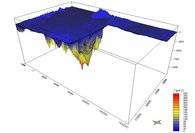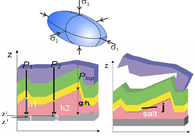Structural Modelling
The integration of geophysical (seismic, seismological, gravity, magnetic, heat flow) data as well as of geological information (stratigraphy, lithology, structure) into consistent models of the basin fill, the crust and the lithosphere is inalienable if we want to derive reasonable boundary conditions concerning the distribution of physical properties and ultimately the allocation of pressure and temperature. Regional 3D structural models per se represent an eclectic base to test different hypotheses. Besides being useful to structural analysis and to calibrate dynamic forward models, they can be the base for different process-oriented studies, as for example the calculation of present-day temperature and pressure conditions or the reconstruction of basin history including the evolution of subsidence, sedimentation, temperature and pressure.
Temperature Field
Knowing the present state of the thermal field as well as understanding the coupling between fluid-and heat transport in basins, is of societal relevance in particular for the exploration of energy resources or water. Based on the 3D structural models we test which configuration of thermal properties is consistent with observed temperatures in wells or with heat flow measured at the surface. We predict deep temperature distribution in sedimentary basins by means of 3D numerical simulations to evaluate which heat transport mechanisms are relevant at which scale and address separately the effects of conductive heat transport as well as the coupled transport of heat and pore fluids.
Gravity Field
Often the information available to describe the deep structure of the lithosphere under sedimentary basins is restricted to local deep seismic profiles and sparse information from seismology. Here 3D gravity modelling provides a helpful tool to derive the spatial distribution of densities at depth. Using relationships between seismic velocities and densities established in lab experiments we derive density models the cumulative 3D gravity response of which is consistent with observed gravity. A particular strength of 3D gravity modelling is that layers at different depths produce a gravity signal of characteristic wavelength and that the non-uniqueness of 2D gravity models is severely reduced if the true 3D influence of mass is considered.
Deformation
In response to changing stress fields sedimentary basins experience deformation the mode of which may be decisively influenced by the presence of internal rheological heterogeneities as the presence of salt layers or of structural inheritance. Methods used to quantify the influence of such factors comprise subsidence analysis and paleo-stress analysis as well as structural restoration including 3D backstripping with salt redistribution. To assess the general processes that govern the subsidence of basins, comparative studies are required that evaluate the subsidence pattern of basins in different plate-tectonic settings in time and space.








